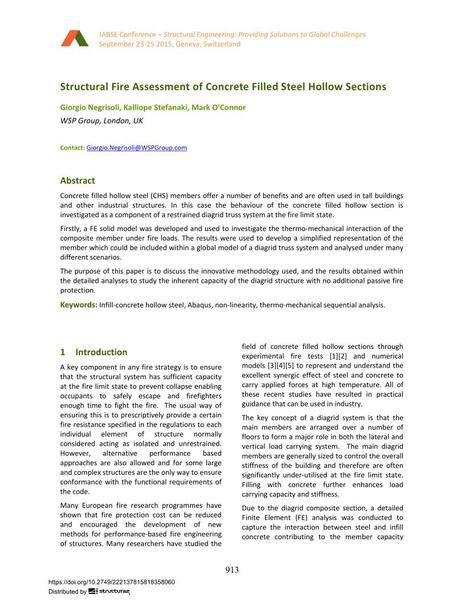Structural Fire Assessment of Concrete Filled Steel Hollow Sections

|
|
|||||||||||
Bibliografische Angaben
| Autor(en): |
Giorgio Negrisoli
(WSP Group, London, UK)
Kalliope Stefanaki (WSP Group, London, UK) Mark O'Connor (WSP Group, London, UK) |
||||
|---|---|---|---|---|---|
| Medium: | Tagungsbeitrag | ||||
| Sprache(n): | Englisch | ||||
| Tagung: | IABSE Conference: Structural Engineering: Providing Solutions to Global Challenges, Geneva, Switzerland, September 2015 | ||||
| Veröffentlicht in: | IABSE Conference Geneva 2015 | ||||
|
|||||
| Seite(n): | 913-920 | ||||
| Anzahl der Seiten (im PDF): | 8 | ||||
| Jahr: | 2015 | ||||
| DOI: | 10.2749/222137815818358060 | ||||
| Abstrakt: |
Concrete filled hollow steel (CHS) members offer a number of benefits and are often used in tall buildings and other industrial structures. In this case the behaviour of the concrete filled hollow section is investigated as a component of a restrained diagrid truss system at the fire limit state. Firstly, a FE solid model was developed and used to investigate the thermo-mechanical interaction of the composite member under fire loads. The results were used to develop a simplified representation of the member which could be included within a global model of a diagrid truss system and analysed under many different scenarios. The purpose of this paper is to discuss the innovative methodology used, and the results obtained within the detailed analyses to study the inherent capacity of the diagrid structure with no additional passive fire protection. |
||||
| Stichwörter: |
ABAQUS Nichtlinearität
|
||||
